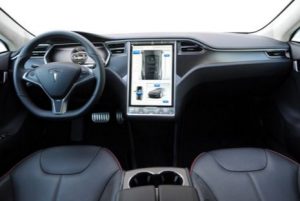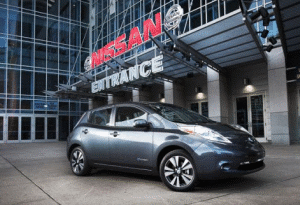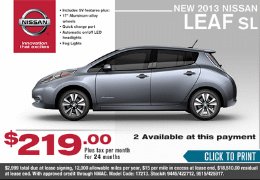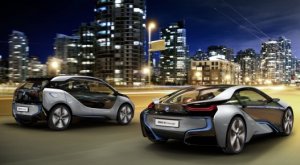by Jon LeSage, editor and publisher, Green Auto Market
Here’s my take on the 10 most significant and interesting occurrences during the past week…….
 Lane changing and self-parking features in Autopilot: Tesla Motors is offering car shoppers a leap forward in autonomous vehicle technology – an option with automated lane changing and self-parking features. As part of Tesla’s new Version 7.0 software package in the Model S, Autopilot will be transmitted to cars in the U.S. over the next week, followed by Europe and Asia. Tesla’s new Model X sport utility vehicle will also offer Version 7.0 and Autopilot. Customers must pay a one-time fee of $2,500 to activate the self-driving software when they buy a car, or $3,000 to activate the feature after delivery. The software update uses cameras, radar, ultrasonic sensors, and data to steer down the highway, change lanes, and adjust speed in response to traffic. The driver can follow a lane on the highway and change lanes using the turn signal. The 7.0 software and Autopilot can deliver parallel parking that detects an open parking space and takes control if the driver asks for the car to park itself.
Lane changing and self-parking features in Autopilot: Tesla Motors is offering car shoppers a leap forward in autonomous vehicle technology – an option with automated lane changing and self-parking features. As part of Tesla’s new Version 7.0 software package in the Model S, Autopilot will be transmitted to cars in the U.S. over the next week, followed by Europe and Asia. Tesla’s new Model X sport utility vehicle will also offer Version 7.0 and Autopilot. Customers must pay a one-time fee of $2,500 to activate the self-driving software when they buy a car, or $3,000 to activate the feature after delivery. The software update uses cameras, radar, ultrasonic sensors, and data to steer down the highway, change lanes, and adjust speed in response to traffic. The driver can follow a lane on the highway and change lanes using the turn signal. The 7.0 software and Autopilot can deliver parallel parking that detects an open parking space and takes control if the driver asks for the car to park itself.- More on VW scandal: Volkswagen continues to be dragged into a quagmire over its TDI diesel models. Three people “familiar with the matter” told Reuters that the automaker made several versions its “defeat device” software to falsify diesel emission tests. Over seven years, VW altered its software for four engine types…… VW will be pulling out of the diesel market, and its competitor General Motors said it will be ramping up its diesel efforts. GM’s Mark Reuss said the upcoming Chevrolet Cruze Diesel and the diesel program for Cadillac are still in the works……. Paramount Pictures and Leonardo DiCaprio’s production company have acquired movie rights to a book proposal by New York Times journalist Jack Ewing about the clean diesel scandal. They’re still in the early stage of production, so the movie won’t be coming out anytime soon.…….. VW plans on bringing more plug-in hybrids and battery electric vehicles to market to shift focus away from its diesel technology. The company is confident it can create components for EVs with ranges as far as 310 miles; that strategy may include redesigning the flagship Phaeton sedan as a battery electric model.
- Award given at LA Auto Show: The annual Green Car of the Year Award will be named next month at the LA Auto Show. Here are the five 2016 model year finalists: Audi A3 Sportback e-tron: The plug-in hybrid hatchback starts at $37,900 and goes 19 miles on electricity alone through its 8.8 kWh lithium-ion battery. Chevrolet Volt: The revamped Volt has a 20% larger battery with 53 miles per charge and 420 total miles of cruising available. Improved handling and acceleration make it fun to drive. Honda Civic: Honda thinks EPA estimates, which have yet to be released, will be over 40 mpg combined without electrification. Coupe and five-door hatchback variants are coming, and it’s the first Civic to feature a turbocharged engine. Hyundai Sonata: It’s available with gasoline, hybrid-electric, and plug-in powertrains. The plug-in should achieve 24 miles on just battery power, and the hybrid gets about 43 mpg on the highway. Toyota Prius: A smaller battery gives offers more space to store cargo, and Toyota predicts the new Prius will achieve 10% greater mileage than before.
- Prius upgrades: Toyota is providing details on the all-new 2016 Prius, launched at a Las Vegas event about five weeks ago. Buyers can choose either its conventional nickel-metal hydride batteries or a more advanced lithium-ion battery pack. Toyota says the drivetrain is more efficient – improved aerodynamics, weight-saving measures, and a re-engineered powertrain, should bring a 10% fuel economy improvement. The new Prius is being launched during a time when the long-anticipated Mirai hydrogen fuel cell car comes the U.S. In Tokyo last week, Senior Managing Officer Kiyotaka Ise said during an environmental forum that the global automaker plan to stop manufacturing traditional gasoline engine vehicles by 2050. Toyota wants a 90% cut in carbon dioxide emissions from new vehicles by 2050, compared with 2010 levels. That will come from hydrogen fuel cell vehicles, hybrids, and electric cars.
- HorseFly electric drone: The Workhorse battery electric “HorseFly” package delivery drone has won U.S. Federal Aviation Administration authorization for test flights. It’s been designed to work in tandem with Workhorse battery electric delivery trucks, reducing driver workload. Testing has been granted at the Ohio/Indiana UAS Center and Test Complex.
- Drive the Dream EV event: Last week, the California Plug-In Electric Vehicle Collaborative, Governor Jerry Brown and a group of more than 40 California leaders met at Drive the Dream 2015. The group announced new initiatives aimed at accelerating the continued adoption of plug-in electric vehicles and workplace charging in the state. Announcements to deploy more electric vehicles and charging stations were made by the U.S. Department of the Navy, Honda, San Diego Gas and Electric, NBCUniversal, PG&E, Coca-Cola Co., Los Angeles Department of Water and Power, Ford, Southern California Edison, NRG, CBRE, and Vision Fleet.
- Honda charging stations: American Honda Motor Co. is adding 120 new electric vehicle (EV) chargers at its Torrance, Calif., headquarters. The new chargers will be installed in two phases, the first of which has already begun. Ultimately, Honda estimates that the chargers will enable hundreds of associates to use an EV for commuting to work.
- Volvo electric targets: Volvo is developing its first all-electric car and broadening its range of plug-in hybrid vehicles, and expects electrified models will account for 10% of its global sales by 2020. The automaker will bring plug-in hybrid technology to its 40-series vehicles; and will offer the full-electric vehicle by 2019.
- Westport and Volvo Group Deal: Westport Innovations has entered into new agreements with Volvo Group for the development, commercial launch and supply of Westport High Pressure Direct Injection (HPDI) 2.0 technology in its heavy-duty trucks over the next several years. Westport says that HPDI 2.0 continues to be the only natural gas system that can offer “same as diesel” horsepower, torque, transient response, engine braking power and fuel economy. It also provides up to 20% reduction in greenhouse gas emissions compared to equivalent diesel engines.
- Investing in EV technology: Pacific Gas and Electric Company (PG&E) plans to invest one-third of its annual fleet purchases in electric vehicles and plug-in hybrid vehicles over the next five years, totaling more than $100 million. PG&E operates approximately 1,400 plug-in electric and electric hybrid vehicles, one of the largest fleets of plug-ins in the nation. The $100 million investment will add more than 750 plug-in electric units to PG&E’s fleet of over 14,000 vehicles.




